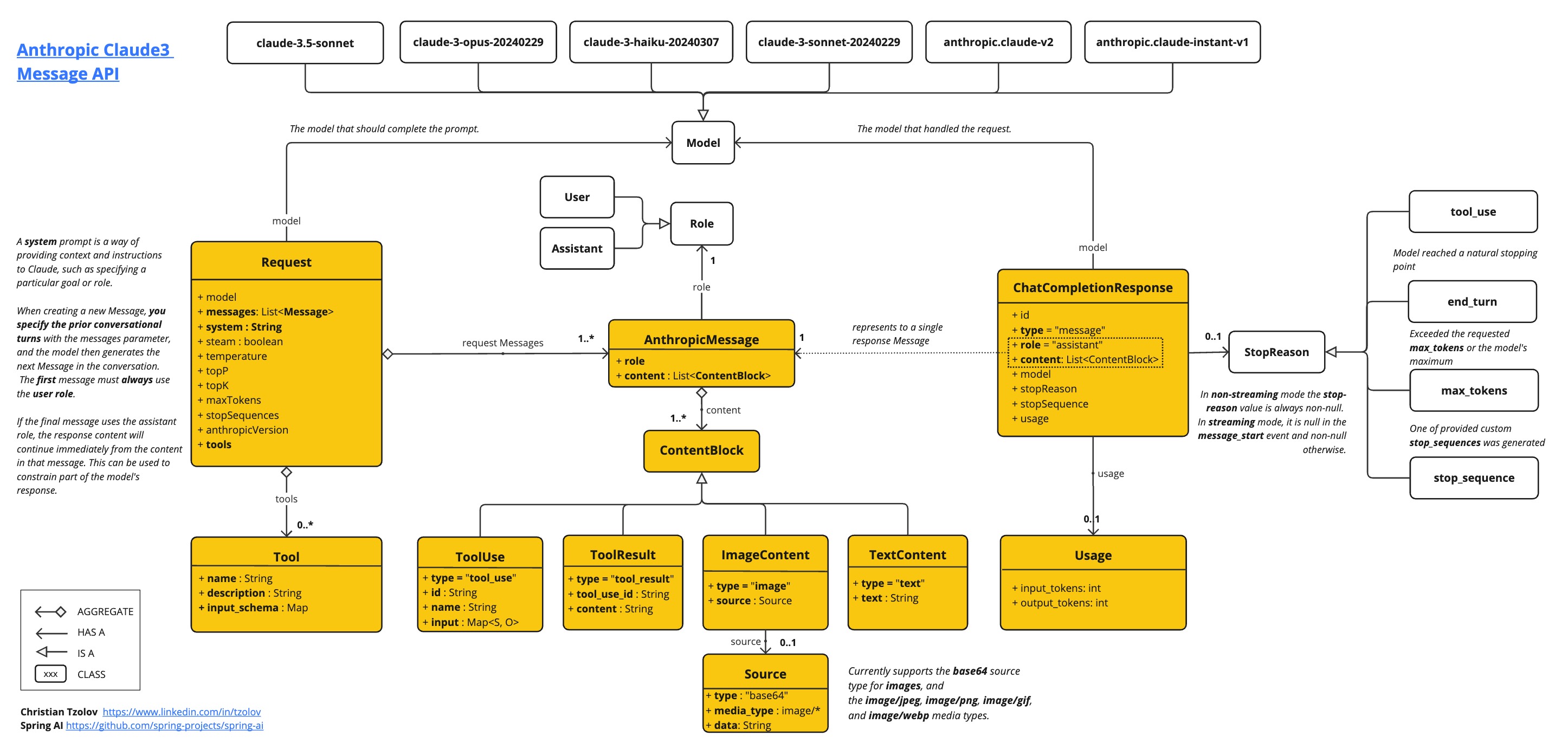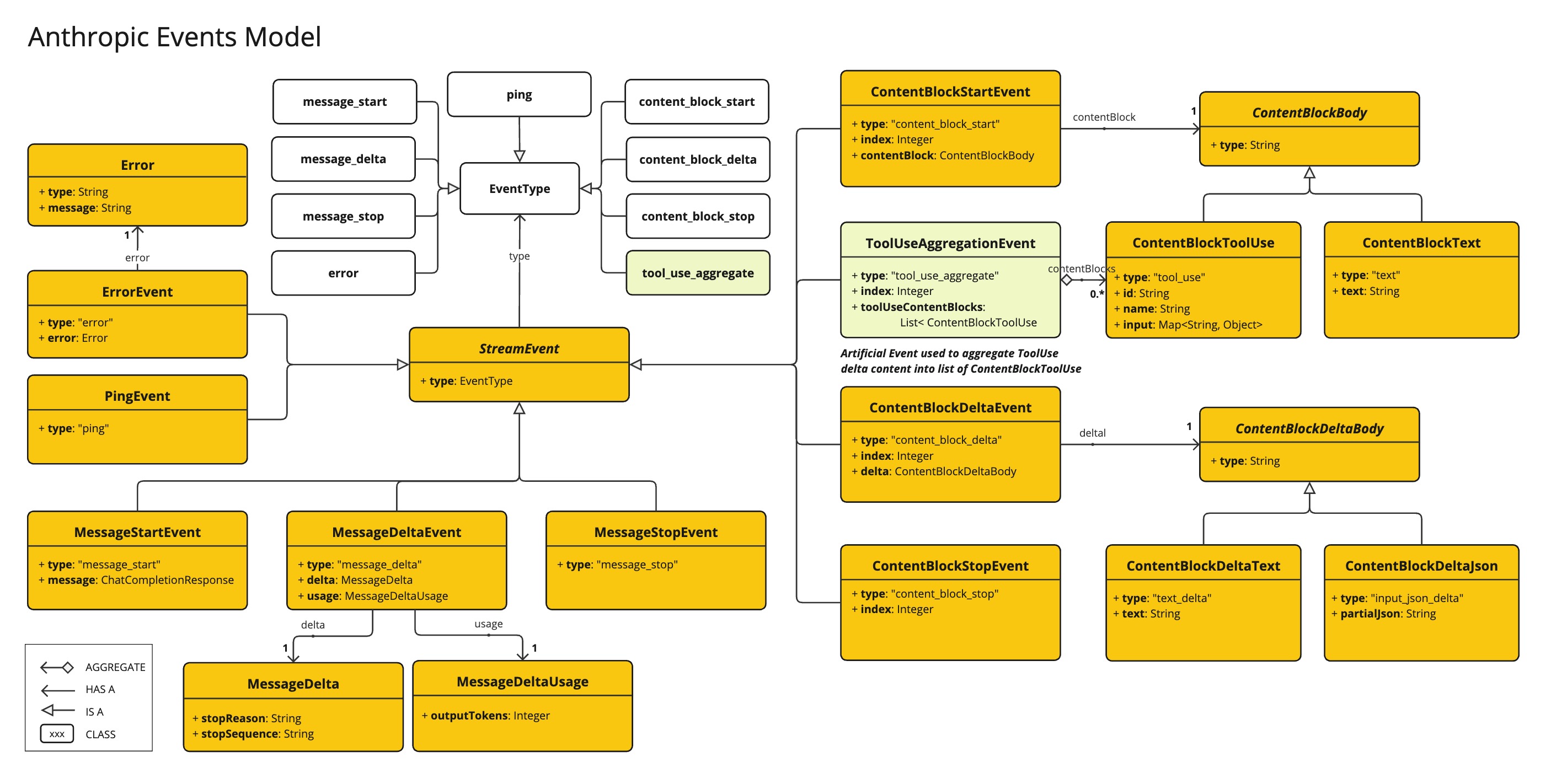Anthropic Chat
Anthropic Claude 是一系列基础 AI 模型,可用于各种应用。 对于开发者和企业,您可以利用 API 访问并直接在 Anthropic 的 AI 基础设施之上进行构建。 Spring AI 支持 Anthropic 消息 API,用于同步和流式文本生成。
|
Anthropic 的 Claude 模型也可通过 Amazon Bedrock Converse 获得。 Spring AI 也提供了专用的 Amazon Bedrock Converse Anthropic 客户端实现。 |
前提条件
您需要在 Anthropic 门户上创建 API 密钥。
在 Anthropic API 仪表板上创建账户,并在 获取 API 密钥页面生成 API 密钥。
Spring AI 项目定义了一个名为 spring.ai.anthropic.api-key 的配置属性,您应该将其设置为从 anthropic.com 获取的 `API 密钥`的值。
您可以在 application.properties 文件中设置此配置属性:
spring.ai.anthropic.api-key=<您的 Anthropic API 密钥>为了在处理 API 密钥等敏感信息时增强安全性,您可以使用 Spring 表达式语言 (SpEL) 引用自定义环境变量:
# 在 application.yml 中
spring:
ai:
anthropic:
api-key: ${ANTHROPIC_API_KEY}# 在您的环境或 .env 文件中
export ANTHROPIC_API_KEY=<您的 Anthropic API 密钥>您也可以在应用程序代码中以编程方式获取此配置:
// 从安全来源或环境变量中检索 API 密钥
String apiKey = System.getenv("ANTHROPIC_API_KEY");自动配置
|
Spring AI 自动配置、启动器模块的工件名称发生了重大变化。 有关更多信息,请参阅 升级说明。 |
Spring AI 为 Anthropic Chat 客户端提供了 Spring Boot 自动配置。
要启用它,请将以下依赖项添加到您的项目的 Maven pom.xml 或 Gradle build.gradle 文件中:
-
Maven
-
Gradle
<dependency>
<groupId>org.springframework.ai</groupId>
<artifactId>spring-ai-starter-model-anthropic</artifactId>
</dependency>dependencies {
implementation 'org.springframework.ai:spring-ai-starter-model-anthropic'
}|
请参阅 依赖管理 部分,将 Spring AI BOM 添加到您的构建文件中。 |
聊天属性
重试属性
前缀 spring.ai.retry 用作属性前缀,允许您配置 Anthropic 聊天模型的重试机制。
| 属性 | 描述 | 默认值 |
|---|---|---|
spring.ai.retry.max-attempts |
最大重试次数。 |
10 |
spring.ai.retry.backoff.initial-interval |
指数退避策略的初始睡眠持续时间。 |
2 秒 |
spring.ai.retry.backoff.multiplier |
退避间隔乘数。 |
5 |
spring.ai.retry.backoff.max-interval |
最大退避持续时间。 |
3 分钟 |
spring.ai.retry.on-client-errors |
如果为 false,则抛出 NonTransientAiException,并且不尝试对 |
false |
spring.ai.retry.exclude-on-http-codes |
不应触发重试(例如,抛出 NonTransientAiException)的 HTTP 状态代码列表。 |
空 |
spring.ai.retry.on-http-codes |
应触发重试(例如,抛出 TransientAiException)的 HTTP 状态代码列表。 |
空 |
|
目前重试策略不适用于流式 API。 |
连接属性
前缀 spring.ai.anthropic 用作属性前缀,允许您连接到 Anthropic。
| 属性 | 描述 | 默认值 |
|---|---|---|
spring.ai.anthropic.base-url |
要连接的 URL |
[role="bare"][role="bare"][role="bare"]https://api.anthropic.com |
spring.ai.anthropic.completions-path |
要附加到基本 URL 的路径。 |
|
spring.ai.anthropic.version |
Anthropic API 版本 |
2023-06-01 |
spring.ai.anthropic.api-key |
API 密钥 |
- |
spring.ai.anthropic.beta-version |
启用新/实验性功能。如果设置为 |
|
配置属性
|
聊天自动配置的启用和禁用现在通过前缀为 |
前缀 spring.ai.anthropic.chat 是属性前缀,允许您配置 Anthropic 的聊天模型实现。
| 属性 | 描述 | 默认值 |
|---|---|---|
spring.ai.anthropic.chat.enabled (已移除,不再有效) |
启用 Anthropic 聊天模型。 |
true |
spring.ai.model.chat |
启用 Anthropic 聊天模型。 |
anthropic |
spring.ai.anthropic.chat.options.model |
要使用的 Anthropic 聊天模型。支持: |
|
spring.ai.anthropic.chat.options.temperature |
用于控制生成补全的明显创造性的采样温度。较高的值将使输出更随机,而较低的值将使结果更集中和确定性。不建议在相同的补全请求中修改温度和 top_p,因为这两个设置的交互难以预测。 |
0.8 |
spring.ai.anthropic.chat.options.max-tokens |
在聊天补全中生成的最大令牌数。输入令牌和生成令牌的总长度受模型上下文长度的限制。 |
500 |
spring.ai.anthropic.chat.options.stop-sequence |
将导致模型停止生成的自定义文本序列。我们的模型通常会在自然完成其轮次时停止,这将导致响应 |
- |
spring.ai.anthropic.chat.options.top-p |
使用核采样。在核采样中,我们以递减概率顺序计算每个后续令牌所有选项的累积分布,并在达到由 top_p 指定的特定概率时将其截断。您应该只更改温度或 top_p,而不是两者都更改。仅推荐用于高级用例。您通常只需要使用温度。 |
- |
spring.ai.anthropic.chat.options.top-k |
仅从每个后续令牌的前 K 个选项中采样。用于删除“长尾”低概率响应。在此处了解更多技术细节。仅推荐用于高级用例。您通常只需要使用温度。 |
- |
spring.ai.anthropic.chat.options.toolNames |
工具列表,由其名称标识,用于在单个提示请求中启用工具调用。具有这些名称的工具必须存在于 |
- |
spring.ai.anthropic.chat.options.toolCallbacks |
要注册到 |
- |
spring.ai.anthropic.chat.options.internal-tool-execution-enabled |
如果为 false,Spring AI 将不会在内部处理工具调用,而是将其代理给客户端。然后,客户端负责处理工具调用,将其分派给适当的函数,并返回结果。如果为 true(默认值),Spring AI 将在内部处理函数调用。仅适用于支持函数调用的聊天模型 |
true |
(已弃用 - 已替换为 |
函数列表,由其名称标识,用于在单个提示请求中启用函数调用。具有这些名称的函数必须存在于 |
- |
(已弃用 - 已替换为 |
要注册到 |
- |
(已弃用 - 已替换为否定的 |
如果为 true,Spring AI 将不会在内部处理函数调用,而是将其代理给客户端。然后,客户端负责处理函数调用,将其分派给适当的函数,并返回结果。如果为 false(默认值),Spring AI 将在内部处理函数调用。仅适用于支持函数调用的聊天模型 |
false |
spring.ai.anthropic.chat.options.http-headers |
要添加到聊天补全请求的可选 HTTP 标头。 |
- |
|
有关模型别名及其描述的最新列表,请参阅 Anthropic 官方模型别名文档。 |
|
所有带有 |
运行时选项
AnthropicChatOptions.java 提供了模型配置,例如要使用的模型、温度、最大令牌计数等。
在启动时,可以使用 AnthropicChatModel(api, options) 构造函数或 spring.ai.anthropic.chat.options.* 属性配置默认选项。
在运行时,您可以通过向 Prompt 调用添加新的、请求特定的选项来覆盖默认选项。
例如,要为特定请求覆盖默认模型和温度:
ChatResponse response = chatModel.call(
new Prompt(
"生成 5 位著名海盗的名字。",
AnthropicChatOptions.builder()
.model("claude-3-7-sonnet-latest")
.temperature(0.4)
.build()
));|
除了模型特定的 AnthropicChatOptions 之外,您还可以使用通过 ChatOptions#builder() 创建的可移植 ChatOptions 实例。 |
思维
Anthropic Claude 模型支持“思维”功能,允许模型在提供最终答案之前显示其推理过程。此功能实现了更透明和详细的问题解决,特别是对于需要逐步推理的复杂问题。
|
支持的模型 思维功能受以下 Claude 模型支持:
模型能力:
API 请求结构在所有支持的模型中都相同,但输出行为有所不同。 |
思维配置
要在任何受支持的 Claude 模型上启用思维,请在您的请求中包含以下配置:
必需配置
-
添加
thinking对象:-
"type": "enabled" -
budget_tokens:推理的令牌限制(建议从 1024 开始)
-
-
令牌预算规则:
-
budget_tokens通常必须小于max_tokens -
Claude 可能会使用比分配的更少的令牌
-
更大的预算会增加推理深度,但可能会影响延迟
-
当使用交错思维的工具使用时(仅限 Claude 4),此限制会放宽,但 Spring AI 尚不支持。
-
关键注意事项
-
Claude 3.7 在响应中返回完整的思维内容
-
Claude 4 返回模型内部推理的*摘要*版本,以减少延迟并保护敏感内容
-
思维令牌是可计费的,作为输出令牌的一部分(即使并非所有都可见于响应中)
-
*交错思维*仅在 Claude 4 模型上可用,并且需要 beta 标头
interleaved-thinking-2025-05-14
工具集成和交错思维
Claude 4 模型支持交错思维与工具使用,允许模型在工具调用之间进行推理。
|
当前的 Spring AI 实现分别支持基本思维和工具使用,但尚不支持交错思维与工具使用(即思维在多个工具调用中继续)。 |
有关交错思维与工具使用的详细信息,请参阅 Anthropic 文档。
非流式示例
以下是如何使用 ChatClient API 在非流式请求中启用思维:
ChatClient chatClient = ChatClient.create(chatModel);
// 对于 Claude 3.7 Sonnet - 需要明确的思维配置
ChatResponse response = chatClient.prompt()
.options(AnthropicChatOptions.builder()
.model("claude-3-7-sonnet-latest")
.temperature(1.0) // 启用思维时,温度应设置为 1
.maxTokens(8192)
.thinking(AnthropicApi.ThinkingType.ENABLED, 2048) // 必须 ≥1024 且 < max_tokens
.build())
.user("是否存在无限个素数使得 n mod 4 == 3?")
.call()
.chatResponse();
// 对于 Claude 4 模型 - 默认启用思维
ChatResponse response4 = chatClient.prompt()
.options(AnthropicChatOptions.builder()
.model("claude-opus-4-0")
.maxTokens(8192)
// 无需明确的思维配置
.build())
.user("是否存在无限个素数使得 n mod 4 == 3?")
.call()
.chatResponse();
// 处理可能包含思维内容的响应
for (Generation generation : response.getResults()) {
AssistantMessage message = generation.getOutput();
if (message.getText() != null) {
// 常规文本响应
System.out.println("文本响应:" + message.getText());
}
else if (message.getMetadata().containsKey("signature")) {
// 思维内容
System.out.println("思维:" + message.getMetadata().get("thinking"));
System.out.println("签名:" + message.getMetadata().get("signature"));
}
}流式示例
您也可以将思维与流式响应一起使用:
ChatClient chatClient = ChatClient.create(chatModel);
// 对于 Claude 3.7 Sonnet - 明确的思维配置
Flux<ChatResponse> responseFlux = chatClient.prompt()
.options(AnthropicChatOptions.builder()
.model("claude-3-7-sonnet-latest")
.temperature(1.0)
.maxTokens(8192)
.thinking(AnthropicApi.ThinkingType.ENABLED, 2048)
.build())
.user("是否存在无限个素数使得 n mod 4 == 3?")
.stream();
// 对于 Claude 4 模型 - 默认启用思维
Flux<ChatResponse> responseFlux4 = chatClient.prompt()
.options(AnthropicChatOptions.builder()
.model("claude-opus-4-0")
.maxTokens(8192)
// 无需明确的思维配置
.build())
.user("是否存在无限个素数使得 n mod 4 == 3?")
.stream();
// 对于流式传输,您可能只想收集文本响应
String textContent = responseFlux.collectList()
.block()
.stream()
.map(ChatResponse::getResults)
.flatMap(List::stream)
.map(Generation::getOutput)
.map(AssistantMessage::getText)
.filter(text -> text != null && !text.isBlank())
.collect(Collectors.joining());工具/函数调用
您可以使用 AnthropicChatModel 注册自定义 Java 工具,并让 Anthropic Claude 模型智能地选择输出一个 JSON 对象,其中包含调用一个或多个已注册函数的参数。
这是一种将 LLM 功能与外部工具和 API 连接起来的强大技术。
阅读有关 工具调用 的更多信息。
多模态
多模态是指模型同时理解和处理来自各种来源信息的能力,包括文本、PDF、图像、数据格式。
图像
目前,Anthropic Claude 3 支持 images 的 base64 源类型,以及 image/jpeg、image/png、image/gif 和 image/webp 媒体类型。
有关更多信息,请查阅 视觉指南。
Anthropic Claude 3.5 Sonnet 还支持 application/pdf 文件的 pdf 源类型。
Spring AI 的 Message 接口通过引入媒体类型支持多模态 AI 模型。
此类型包含消息中媒体附件的数据和信息,使用 Spring 的 org.springframework.util.MimeType 和 java.lang.Object 作为原始媒体数据。
下面是一个简单的代码示例,摘自 AnthropicChatModelIT.java,演示了用户文本与图像的组合。
var imageData = new ClassPathResource("/multimodal.test.png");
var userMessage = new UserMessage("解释一下你在这张图片上看到了什么?",
List.of(new Media(MimeTypeUtils.IMAGE_PNG, this.imageData)));
ChatResponse response = chatModel.call(new Prompt(List.of(this.userMessage)));
logger.info(response.getResult().getOutput().getContent());它将 multimodal.test.png 图像作为输入:

以及文本消息“解释一下你在这张图片上看到了什么?”,并生成类似以下内容的响应:
图像显示了一个装有几片水果的铁丝水果篮的特写。 ...
从 Sonnet 3.5 开始,提供了 PDF 支持(测试版)。
使用 application/pdf 媒体类型将 PDF 文件附加到消息中:
var pdfData = new ClassPathResource("/spring-ai-reference-overview.pdf");
var userMessage = new UserMessage(
"您是一位非常专业的文档摘要专家。请总结给定的文档。",
List.of(new Media(new MimeType("application", "pdf"), pdfData)));
var response = this.chatModel.call(new Prompt(List.of(userMessage)));示例控制器
创建一个新的 Spring Boot 项目,并将 spring-ai-starter-model-anthropic 添加到您的 pom(或 gradle)依赖项中。
在 src/main/resources 目录下添加一个 application.properties 文件,以启用和配置 Anthropic 聊天模型:
spring.ai.anthropic.api-key=您的_API_密钥
spring.ai.anthropic.chat.options.model=claude-3-5-sonnet-latest
spring.ai.anthropic.chat.options.temperature=0.7
spring.ai.anthropic.chat.options.max-tokens=450|
将 |
这将创建一个 AnthropicChatModel 实现,您可以将其注入到您的类中。
这是一个简单的 @Controller 类的示例,它使用聊天模型进行文本生成。
@RestController
public class ChatController {
private final AnthropicChatModel chatModel;
@Autowired
public ChatController(AnthropicChatModel chatModel) {
this.chatModel = chatModel;
}
@GetMapping("/ai/generate")
public Map generate(@RequestParam(value = "message", defaultValue = "讲个笑话") String message) {
return Map.of("generation", this.chatModel.call(message));
}
@GetMapping("/ai/generateStream")
public Flux<ChatResponse> generateStream(@RequestParam(value = "message", defaultValue = "讲个笑话") String message) {
Prompt prompt = new Prompt(new UserMessage(message));
return this.chatModel.stream(prompt);
}
}手动配置
AnthropicChatModel 实现了 ChatModel 和 StreamingChatModel,并使用 低级 AnthropicApi 客户端 连接到 Anthropic 服务。
将 spring-ai-anthropic 依赖项添加到您的项目的 Maven pom.xml 文件中:
<dependency>
<groupId>org.springframework.ai</groupId>
<artifactId>spring-ai-anthropic</artifactId>
</dependency>或添加到您的 Gradle build.gradle 构建文件中。
dependencies {
implementation 'org.springframework.ai:spring-ai-anthropic'
}|
请参阅 依赖管理 部分,将 Spring AI BOM 添加到您的构建文件中。 |
接下来,创建一个 AnthropicChatModel 并将其用于文本生成:
var anthropicApi = new AnthropicApi(System.getenv("ANTHROPIC_API_KEY"));
var anthropicChatOptions = AnthropicChatOptions.builder()
.model("claude-3-7-sonnet-20250219")
.temperature(0.4)
.maxTokens(200)
.build()
var chatModel = AnthropicChatModel.builder().anthropicApi(anthropicApi)
.defaultOptions(anthropicChatOptions).build();
ChatResponse response = this.chatModel.call(
new Prompt("生成 5 位著名海盗的名字。"));
// 或使用流式响应
Flux<ChatResponse> response = this.chatModel.stream(
new Prompt("生成 5 位著名海盗的名字。"));AnthropicChatOptions 提供了聊天请求的配置信息。
AnthropicChatOptions.Builder 是流畅的选项构建器。
低级 AnthropicApi 客户端
AnthropicApi 提供了 Anthropic 消息 API 的轻量级 Java 客户端。
以下类图说明了 AnthropicApi 聊天接口和构建块:


这是一个如何以编程方式使用 API 的简单代码片段:
AnthropicApi anthropicApi =
new AnthropicApi(System.getenv("ANTHROPIC_API_KEY"));
AnthropicMessage chatCompletionMessage = new AnthropicMessage(
List.of(new ContentBlock("讲个笑话?")), Role.USER);
// 同步请求
ResponseEntity<ChatCompletionResponse> response = this.anthropicApi
.chatCompletionEntity(new ChatCompletionRequest(AnthropicApi.ChatModel.CLAUDE_3_OPUS.getValue(),
List.of(this.chatCompletionMessage), null, 100, 0.8, false));
// 流式请求
Flux<StreamResponse> response = this.anthropicApi
.chatCompletionStream(new ChatCompletionRequest(AnthropicApi.ChatModel.CLAUDE_3_OPUS.getValue(),
List.of(this.chatCompletionMessage), null, 100, 0.8, true));请遵循 AnthropicApi.java 的 JavaDoc 以获取更多信息。
低级 API 示例
-
AnthropicApiIT.java 测试提供了一些如何使用轻量级库的通用示例。